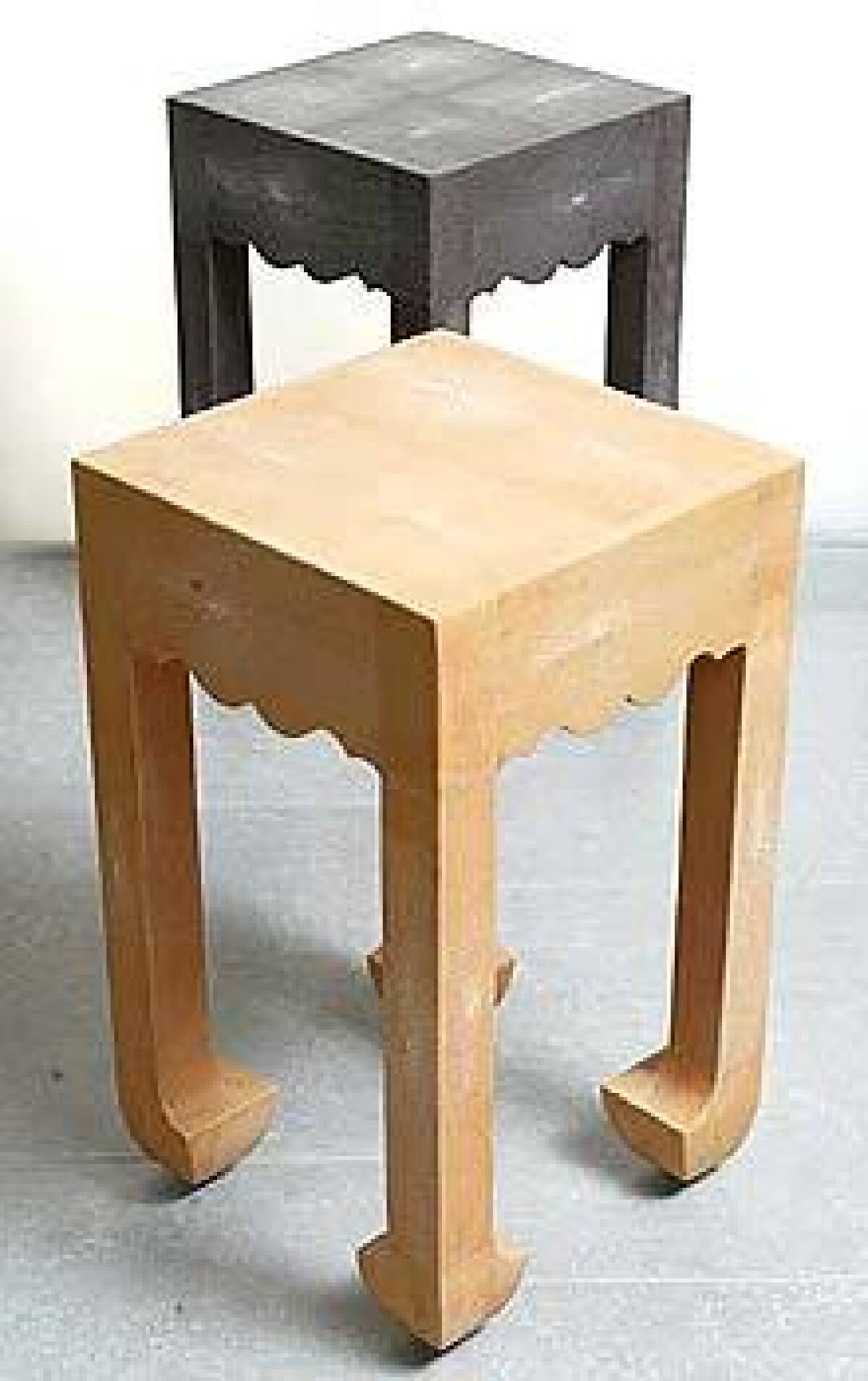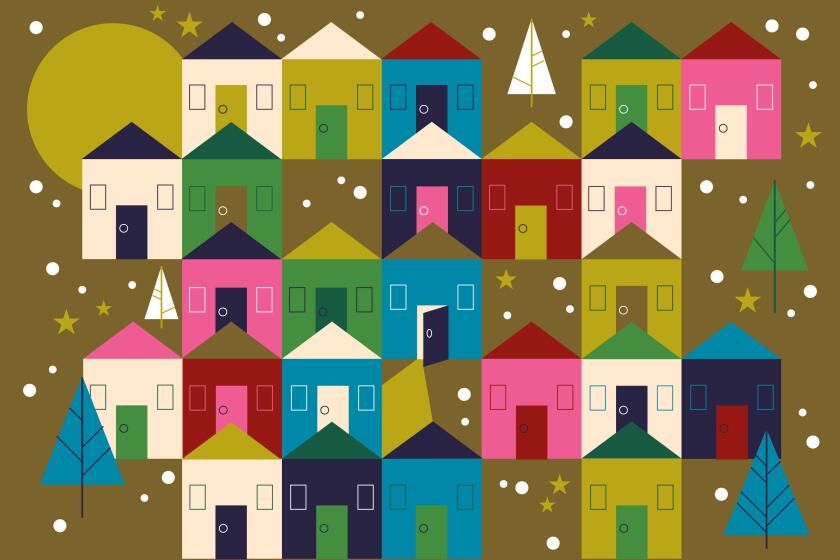Putting the fab back in confab

A small army of decorators, painters, paper hangers and lightbulb changers descended on the Pacific Design Center in West Hollywood. Their mission: to fluff things up for WestWeek.
West what? The annual event, which closes today and actually lasts just two days, is the PDCâs open house party for home design industry movers and shakers. For more than 100 of the centerâs 150 showrooms, that means unveiling new collections.
As a fleet of movers unpacked Kerry Joyceâs sleek updates on midcentury classics and Gregorius-Pineoâs antique reproductions last week, Harry Lawenda, co-owner of longtime PDC tenant Kneedler-Fauchère, reflected on the preparations.
âIt is turmoil,â joked the veteran of 28 WestWeeks.
The action this year has been a far cry from a design convocation so uninspiring in the past that it was not-so-jokingly nicknamed WorstWeek. In the â80s, crowds lined out the door to Melrose Avenue, but during the â90s, the event suffered after many tenants left the PDC, and independent showrooms with hip collections sprung up on Beverly Boulevard. Since 1999 a new owner has reenergized the PDC and WestWeek.
Now the event lures 5,000 West Coast architects, decorators and design fans. Educational lectures and panel discussions cover topics such as âBig Game Hunting: Tracking and Capturing the Elusive Multimillionaire.â Activities include introductions of new products and schmooze sessions with designers who created them, such as Hollywood Regency hotel design queen Kelly Wearstler, who this year launches a fabric collection for Schumacher.
The recreational component could hold its own against any convention where the dress code includes a fez: champagne brunches, afternoon teas, evening cocktail parties and two award ceremonies â the 2005 Stars of Design, which honors Southern California professionals, and House & Garden magazineâs âBest on Bestâ showroom winners, chosen by a survey of professional decorators.
WestWeek is a community service, says Holly Hunt, who will open a 13,000-square-foot showroom in the PDC in May. âIt brings everyone together to think and talk about design. Everybody puts their new designs out, gets all dressed up and has a party.â
Serious business mixes with the pleasure. WestWeek gives designers the chance to view trends and products in the upper echelons of the home décor market. Though the public may attend, showrooms sell âto the trade onlyâ â architects and designers who purchase for clients â and most items carry tags with price codes that are incomprehensible to do-it-yourself redecorators.
During a WestWeek preview, it was clear that the notion of Hollywood glamour â which takes its cues from Art Deco, French Moderne and golden-age movie studio art direction â has not worn out its welcome in Los Angeles. Slipper chairs reminiscent of 1940s styles were sheathed in lavish fabrics and accented with mirror-clad tables in Jan Showersâ collection at the David Sutherland Showroom, and Charles Jacobsenâs low-slung silk sofas and Chinese tables seemed to have emerged from a silent film starâs opium den. Lamps also got the spotlight: The Fuse collection at Thomas Lavin included sconces beaded with semiprecious stones, and Hinson & Co. offered minimalist light fixtures made from ostrich eggs.
Some of the most arresting room settings in the WestWeek showrooms mix damask prints and hand-painted woods with limed oak and Lucite. Luxury suffuses the collections, no matter how streamlined or contemporary, making the divide between traditional and 21st century aesthetics not so vast.
A harness chair in iron by CSI Designs at Christopher Norman has an equestrian profile with buckled leather straps, and the new Italian showroom Thema has a suite of leather-clad home office furniture that includes a stool with a seat die-cut to look like the sprockets in a strip of 35-millimeter film. Shagreen, a hide made from stingrays that was popular in the first half of the 20th century in France, resurfaces in four colors on Asian profiled tables at Greystone.
Ornamentation plays a leading role in redefining Old World forms for the modern eye. Nailhead studs are everywhere, even making their way onto tables. Todd Haseâs Louis XXI collection features contemporary upholstery on traditional French wood bases lacquered in olive green and oxblood red. At Kneedler-Fauchère, the L.A. interior design firm of Hendrix Allardyce is unveiling a 10-years-in-the-making line of neoclassical and Mediterranean designs with lavish details, including leather tufted chairs with buttons shaped into flower buds.
âIt is really remarkable that so much of the finest furniture is designed and manufactured in Southern California,â Kneedler-Fauchèreâs Lawenda says. âThatâs why WestWeek is important: to make the public aware that we are blessed to have these companies here.â
Promoting the Pacific Design Center as an important source for California décor has become the mission of Charles Cohen, who bought the landmark designers call âthe blue whaleâ in 1999, when it was something of a white elephant. Cohen, who also owns the Decoration and Design Building, a collection of to-the-trade showrooms in New York, was âknocked outâ by Cesar Pelliâs architecture and inspired to create âa design center thatâs never been done before.â
The sharply dressed Cohen, 53, who bears a slight resemblance to a young Burt Bacharach, has made the Pacific Design Center a destination for the Hollywood set. It was the site of this yearâs Oscar-viewing party hosted by Elton John and other charity galas.
âI am opening up the public areas of the Pacific Design Center,â he says, âto bring people to our doorstep and hopefully convert them into customers who will visit the showrooms with design professionals.â He says the center has a roster of 15 decorators whose work can be reviewed by potential clients. The manager of this referral program, Robert Ketterman, also can shop for and with individuals (at a cost of $125 an hour) and make purchases from showrooms on their behalf.
In the last six years, Cohen also has brought in a satellite gallery of the Museum of Contemporary Art, renovated the SilverScreen Theatre and opened it to film industry screenings, brought in Charlie Palmerâs Astra West restaurant, built plazas and fountains and added the Oldenburg-esque sculptures of a lamp and chair that have become signatures of the building.
These improvements have raised occupancy to more than 90%, up from 60% in 1999, with recent high-profile showroom additions such as Barclay Butera Home; Hunt, who will premiere an exclusive collection by Rose Tarlow; and Lavin, who represents the hip wallpaper company Twenty2 as well as Wendell Castle, one of the last living midcentury furniture designers.
âItâs a vote of confidence to have tenants like Thomas Lavin, who is young and dynamic, and Holly Hunt, who has five showrooms across the country and is tried and true but still at the forefront of design,â Cohen says.
For Hunt, the decision was a no-brainer.
âItâs like when somebody asked Willie Sutton why he robbed banks and he said, âThatâs where the money is.â New York is still a center, but L.A. is much more design-conscious and willing to spend money.â
David A. Keeps is a frequent contributor to Home. He can be reached at
More to Read
Sign up for The Wild
Weâll help you find the best places to hike, bike and run, as well as the perfect silent spots for meditation and yoga.
You may occasionally receive promotional content from the Los Angeles Times.










